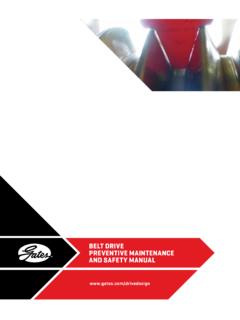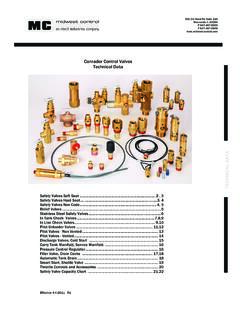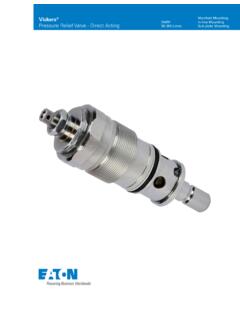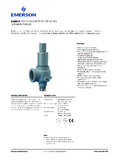Transcription of Technical Documentation valves / Pressure retaining valves ...
1 Pressure reducing valves / Pressure retaining valvesPressure relief valvesSpecial valvesTechnical Documentation 2 3 Page 1. Pressure reducing valve V782 4 2. Pressure reducing valve V82 9 3. Pressure reducing valve V182 14 4. Pressure retaining valve V786 18 5. Pressure retaining valve V186/V86 23 6. Pressure relief valve V185/V85 28 7. Diaphragm Pressure gauge guard Z700/Z701 32 8. Water jet suction pump P20 35 9. Filler and breather valves V95/V91 4510. Float valve V140 4811. Throttle sleeve V251 50 Table of contents 4 Pressure Reducing Valve V782 GeneralFunctionThe V782 Pressure Reducing Valve reduces the Pressure within the system to a pre-set value. By using the differential Pressure , the Pressure reducing valve adjusts itself to the set working Pressure .
2 The outlet Pressure (working Pressure ) is not directly related to the inlet Pressure . If the outlet pressureincreases or decreases above/below the desired value, the diaphragm is lifted against the spring force or pressed down by the spring force, as the case may be, by the outlet Pressure . The Pressure reducing valve begins to close/open until a state of equilibrium is re-established; in other words, the outlet Pressure remains constant irrespective of an increasing or decreasing inlet wide range of materials available for the housings (PVC-U, PP, PVDF) and the dia-phragms (EPDM, EPDM-PTFE-coated) cover many areas of application for technically pure, neutral and aggressive fl uids as well as ultra-pure water applications. For more information,please refer to the Georg Fischer Piping Systems List of Resistance.
3 We recommend installing a strainer upstream to avoid any features All parts in contact with the medium are made of highly resistant plastics. The actuator is separated and hermetically sealed off from the fl ow section by the control diaphragm. The working Pressure is set with an ad-justing screw and locked with a locknut. The streamlined design of the housing makes for good fl ow rates. The large control surface and the spiral spring keep standard tolerances small. No auxiliary energy is required to operate the valve. The valve is largely maintenance-free and can be installed in any position. Valve can also be adjusted under working Pressure . 5 Technical data V782 Available materialsValve housing: PVC-U, PP, PVDFD iaphragm: EPDM, EPDM-PTFE-coatedPressure range: DN 10 40 10 bar Working Pressure Hysteresis approx.
4 To bar Pressure difference between inlet and outlet min. 1 barAllowable working temperaturePVC-U 0 to + 60 CPP 10 to + 80 CPVDF 20 to + 100 CDILHhdaTemper atur e ( C) Pressure (bar)109876543210bar-40 -20 0 +20 +40 +60 +80 +100 +120 +140PP 10 years PVC 10 yearsPVDF 20 yearsPressure/Temperature diagramAttention: If the secondary Pressure is increased additionally by back Pressure , the Pressure regulating valve will act as a check valve. This back Pressure can under certain circumstances lead to the destruction of the valve piston. Adjustment range on outlet with an inlet Pressure of 10 to barCement and fusion spigots according to DIN/ISOD imensions and weight V782da DN L: PVC-U cement spigots L.
5 PVDF-HP/PP I H h D PP/PVDF fusion spigots Butt fusion spigots BC F/IR16 10 134 102 138 48 8320 15 134 172 102 138 48 8325 20 154 190 110 205 65 11232 25 154 190 110 205 65 11240 32 224 262 162 248 95 16550 40 224 262 162 248 95 165da DN Weight (kg) PVC-U PP PVDF16 10 15 20 432 25 440 32 40 6 Operational characteristics for a Pressure reducing valve (representation not full scale)PSPAP Pmin0 QQmaxP PS0pA = formulated operating pressurep = opening pressurepS = closing pressurepS-p = hysteresispS-pA = fl ow-related Pressure drop in valvepS-pmin = max.
6 Pressure reduction in relation to fl ow rateExample 1: For a fl ow rate of approx. 3500 l/hr, an outlet Pressure (working Pressure ) of 4 bar is Pressure min. 5 bar or for the given fl ow rate on the x axis of the respective nominal diameter curve. When the appropriate curve has been found, check if the valve is in the desired Pressure range (here 4 bar). In this example, the hysteresis would be bar and the Pressure drop 1 2: The valve is adjusted at a desired Pressure of 3 bar at 0 conveyance. If we take a fl ow rate of 2500 l/hr, the Pressure drop in the valve would be approx. in valvel/hrbarFlow rate Q l/hrPressuredecrease insidethe valveHysteresisWorking Pressure pA bar 7 Characteristics V782109876543210bar0 l/h 200 400 6000 l/min 10109876543210barDN 150 l/h 400 800 12000 l/min l/h 1000 20000 l/min
7 20109876543210bar0 l/h 3000 60000 l/min 50 100DN 32109876543210bar0 l/h 5000 90000 l/min 150DN 40109876543210bar0 l/h 1000 2000 3000 40000 l/min 50 25l/hr = Flow volume H2O* PVDF PTFE Standard with IR spigots on requestFlange and union versions on requestCharacteristics are valid for a fl ow rate of 2 m/sOutlet pressureOutlet pressureOutlet pressureOutlet pressureOutlet pressureOutlet pressureOrder numberDN d Adj.
8 Range PVC-U PP Standard PP/IR spigots PVDF-PTFE HP-Version* in bar EPDM PTFE EPDM PTFE EPDM PTFE Standard BCF/IR spigots10 16 199 041 060 199 041 066 199 041 072 199 041 078 199 041 084 15 20 199 041 061 199 041 067 199 041 073 199 041 079 199 041 299 199 041 404 199 041 085 199 041 19220 25 199 041 062 199 041 068 199 041 074 199 041 080 199 041 300 199 041 405 199 041 086 199 041 19325 32 199 041 063 199 041 069 199 041 075 199 041 081 199 041 301 199 041 406 199 041 087 199 041 19432 40 199 041 064 199 041 070 199 041 076 199 041 082 199 041 302 199 041 407 199 041 088 199 041 19540 50 199 041 065 199 041 071 199 041 077 199 041 083 199 041 303 199 041 408 199 041 089 199 041 196 810 5 2 3 4121714151116 6 91 Sectional drawing V782 PartsNo.
9 Description 1. Valve body 2. Uppervalve body 3.* Diaphragm 4.* Piston 5. V782: Compressor 6. V782: Spring plate 9.* Compression spring 10. Lock nut 11. Adjusting screw 12. Hexagonal socket-head bolt 14. Cap15. Hexagonal socket-head bolt with nut and covering cup16. Valve bottom with O-ring17.* Ring seal* Parts subject to wear or recommended spare parts1. Dismantle the upper valve Put the valve in an upright Unscrew the cap (14) Undo the locknut on the adjusting screw (11) and undo the adjusting screw until the compression spring (9) is fully Remove the covering caps on the screws (15) of the upper body and undo the Lift the upper body (2) upwards and remove the spring plate (6) and the spring (9)Dismantling instructions2.
10 Dismantle the lower valve body and the Carry out steps to Unscrew the vent plug (16) Lay the valve on its With a screwdriver on the underside of the piston (vent plug opening), prevent the piston from turning and at the same time use a hexagon socket screw key to unscrew the screw (12) in the Pressure plate (5) Remove the screw (12), Pressure plate (5) and dia-phragm (3) Remove the piston (4) Remove the ring seal (17) in the housing (1) These steps are carried out in reverse order to reassemble! Operating faults and possible causesFault Cause CorrectionValve not sealed at the diaphragm Diaphragm not pressed on hard enough Tighten screws (15) Pressure rises above the set value Piston (4) not sealed Check piston and piston position and possibly replace Diaphragm (3) not sealed Replace diaphragm, dismantle upper valve body Ring seal (17)











